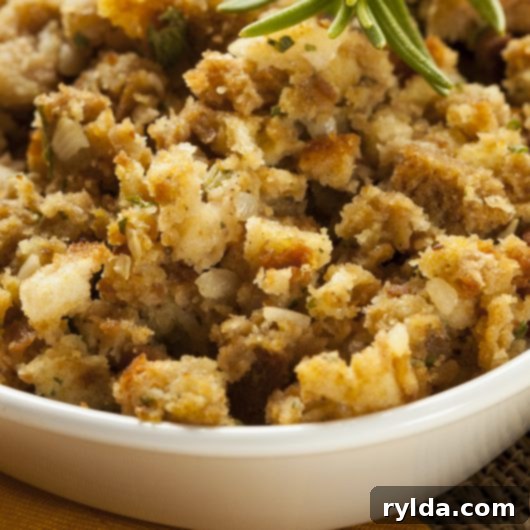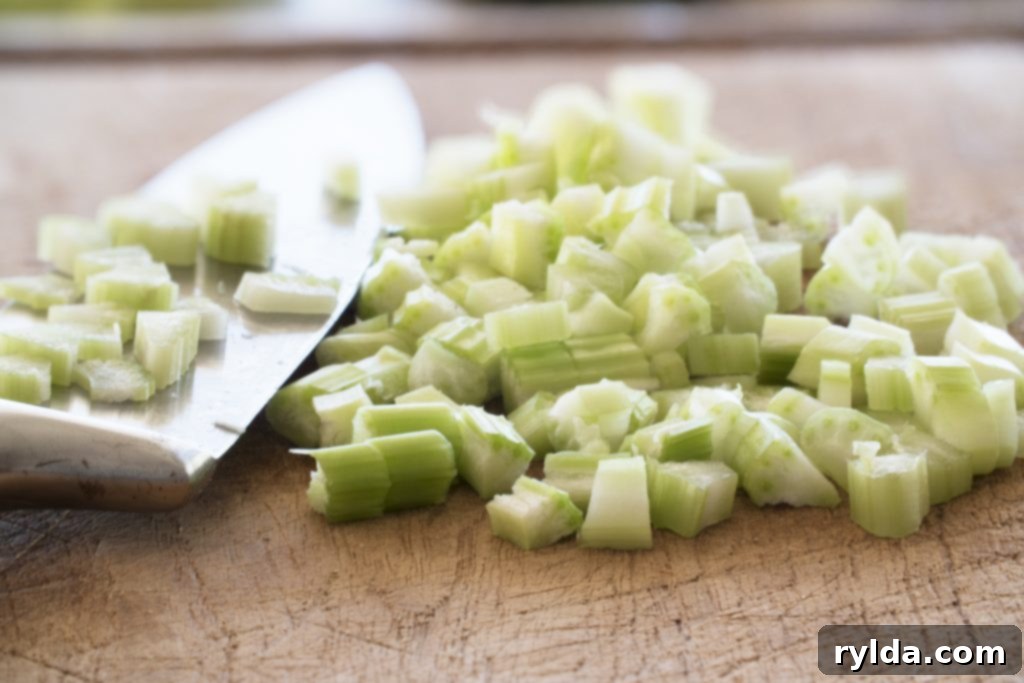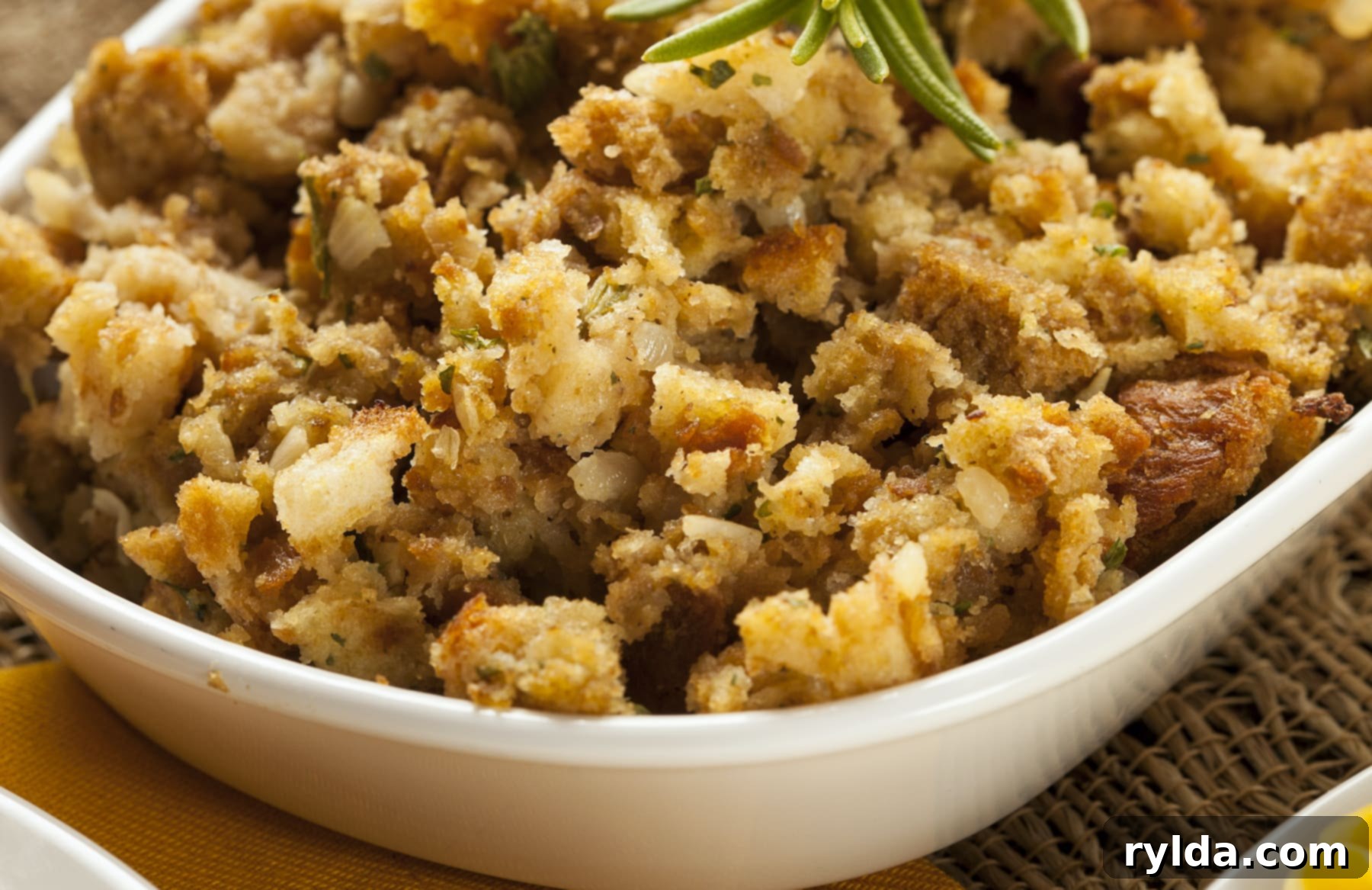Classic Homemade Stuffing: A Timeless Recipe for Your Holiday Table
There’s an undeniable magic in that very first bite of stuffing, especially when it graces a festive holiday table. It’s often the unsung hero, the comforting cornerstone that brings together all the savory flavors of a celebratory feast into one harmonious, delicious mouthful. This particular recipe for Simple Homemade Stuffing holds a special place in my heart because it tastes exactly like the Thanksgivings and Christmases I cherished as a child. While I occasionally experiment with more adventurous variations featuring ingredients like sausages, cranberries, or apples, this straightforward, classic version is what truly complements a grand roast turkey or a succulent prime rib, evoking a profound sense of nostalgia and tradition.

The Foundation: Choosing and Preparing Your Bread
The secret to exceptional stuffing begins with the bread. For this recipe, I typically start with a fresh loaf of French bread from my local grocery store’s bakery. If a good French loaf isn’t available, baguettes make an excellent substitute; generally, one and a half baguettes will yield a similar volume of bread cubes to a standard French bread loaf. I find it best to purchase the bread two days before my meal and then cube and dry it the day before I plan to assemble the stuffing. While you can certainly dry the bread on the same day, allowing the bread to cool completely after drying is crucial for achieving the perfect texture and preventing a soggy stuffing.
Why Day-Old and Why Dry Your Bread?
Using day-old bread, or actively drying fresh bread, is not merely a suggestion – it’s a fundamental step that greatly impacts the final texture of your stuffing. Fresh bread contains too much moisture, which can lead to a dense, gummy, or overly soft stuffing. By drying the bread, you create porous cubes that are ready to absorb all the rich, buttery, and seasoned chicken stock. This absorption is key to developing that desirable balance of tender interior and slightly crispy edges that defines truly great stuffing.
Exploring Bread Substitutions for Stuffing
While French bread is my personal favorite for its neutral flavor and sturdy structure, many other types of bread can absolutely be used for stuffing. It’s important to note that different breads will indeed yield distinctly different results. For instance, a hearty sourdough will impart a tangy note, while a sweet challah bread can add a subtle richness. Plain sliced white sandwich bread is a fantastic and accessible substitute if you’re looking for a similar mild flavor profile to French bread. However, I strongly advise against using breads that contain nuts or seeds, as these can detract from the classic stuffing texture and flavor we’re aiming for. Experimentation can lead to interesting variations, but always consider how the bread’s inherent characteristics will influence the overall dish.

Simple Homemade Stuffing
3.3 from 151 votes
10
servings
40
minutes
40
minutes
This simple homemade French bread stuffing is a timeless classic, delivering the rich, savory, and buttery flavors you remember from cherished childhood holiday meals. Perfect as a comforting side for Thanksgiving, Christmas, or any special occasion, it’s designed to be effortlessly delicious.
Ingredients for Your Classic Homemade Stuffing
Gather these essential ingredients to create a truly memorable holiday side dish:
-
1 loaf 1 French bread, day old (or 1 1/2 loaves day old baguette)
-
2-3 cups 2-3 Chicken stock (or vegetable/turkey stock)
-
1 cup 1 Unsalted Butter (2 sticks)
-
1 1 Large Onion, finely diced
-
4 stalks 4 Celery, finely diced
-
1 1/2 tablespoons 1 1/2 Poultry seasoning
-
1 teaspoon 1 Dried oregano
-
1/2 teaspoon 1/2 Dried crushed rosemary
-
1 teaspoon 1 Salt (or to taste)
-
Fresh ground black pepper to taste
Step-by-Step Instructions for Flawless Homemade Stuffing
- PREPARING THE BREAD CUBES (DRYING)
- Cut and Spread: Up to one day ahead, but at an absolute minimum of 4 hours before you plan to make the stuffing, carefully cut your French bread into uniform cubes. Aim for pieces that are roughly bite-sized (about 1/2 to 3/4 inch). Spread these bread pieces in a single, even layer across one or two large cookie sheets lined with parchment paper or aluminum foil. This ensures even drying.
- Dry the Bread: Place the cookie sheets in a preheated oven at 250° F (120° C). Dry the bread, stirring gently every 10-15 minutes, for a total of 45-60 minutes. The goal is for the bread to become very dry and have a texture similar to croutons – crisp but not hard. Once dried, remove from the oven and allow the bread to cool completely. This is crucial as warm bread can introduce steam and moisture back into your stuffing. If you’re drying the bread overnight, store the cooled cubes in paper bag(s) to allow air circulation and prevent moisture buildup.
- ASSEMBLING THE STUFFING
- Preheat and Prepare Dish: Preheat your oven to 350° F (175° C). Grease a large casserole or baking dish (approximately 9×13 inches) with softened butter. This helps prevent sticking and adds a delicious buttery crust.
- Dice Vegetables: Finely dice your onion and celery. Smaller pieces will meld better into the stuffing texture.
- Melt Butter: In a large sauté pan, melt the cup of butter over low to medium-low heat. It’s important to keep the heat low enough so that the butter melts slowly and does not begin to brown. We want that rich, pure butter flavor.
- Sauté Aromatics: Add the diced onion and celery to the melted butter. Toss them thoroughly to ensure they are well coated. Cook for 8-10 minutes, stirring occasionally, until the onions become soft and translucent, and the celery is tender. If you notice the butter starting to brown, reduce the heat immediately.
- Add Seasonings: Stir in the poultry seasoning, dried oregano, dried crushed rosemary, salt, and fresh ground black pepper. Continue to cook over low heat for another 1-2 minutes, allowing the spices to toast slightly and release their full aroma and flavor into the butter and vegetables.
- Incorporate Stock: Pour 2 cups of chicken stock into the sauté pan with the butter and vegetable mixture. Stir thoroughly to combine everything. Let it heat through for 30-60 seconds, then remove the pan from the heat.
- Combine with Bread: Place the thoroughly dried bread cubes into a very large mixing bowl.
- Moisten the Stuffing: Gradually pour the warm stock, butter, and vegetable mixture over the bread cubes, adding about 1 cup at a time. Pause between each addition to gently stir the bread until it’s evenly coated. The goal is to moisten the bread without making it mushy.
- Adjust Moisture and Seasoning: If the stuffing still seems too dry, or if you prefer a more moist stuffing, add some or all of the additional 1 cup of chicken stock, a little at a time, until you reach your desired consistency. Taste the stuffing mixture for seasoning. If it tastes bland, add small pinches of salt until the flavors pop and you are happy with the taste. Remember, it’s easier to add more salt than to fix overly salty stuffing.
- Transfer to Dish: Pour the prepared stuffing mixture into your greased casserole or baking dish. Spread it evenly across the dish and gently press it down slightly.
- BAKING THE STUFFING
- Bake: Cover the dish securely with aluminum foil and bake in the preheated oven for 30 minutes. After 30 minutes, remove the foil and continue to bake for an additional 25-35 minutes, or until the top of the stuffing is beautifully golden brown and has a desirable, slightly dry and crisp texture. Serve this delightful homemade stuffing warm and enjoy!
Helpful Notes & Customization Tips
- Stock Quantity: This recipe suggests a minimum of 2 cups of chicken stock, but the exact amount can vary. Factors like the type of bread, its dryness, and your personal preference for moisture will influence how much stock is needed. Always add stock gradually and adjust to achieve your desired consistency – a little more moisture often results in a tender, flavorful stuffing.
- Stock Alternatives: For versatility, vegetable or turkey stock can be used as excellent substitutes for chicken stock. Both chicken broth and broth made from bouillon cubes will also work wonderfully, offering similar savory depth. However, beef stock is generally not recommended as its strong flavor profile can overpower the delicate balance of seasonings in this stuffing.
- Bread Substitutions: While French bread is ideal, you can substitute it with almost any other sturdy bread, provided the bread is thoroughly dried before use. Keep in mind that different breads will alter the flavor and texture. For example, a brioche or challah will add richness, while sourdough will introduce a tangy note.
- Using Store-Bought Stuffing Mix: If you opt for a pre-dried, store-bought stuffing mix, be mindful of the seasonings. Many mixes are already pre-seasoned, so you may need to significantly decrease the amount of additional spices (poultry seasoning, oregano, rosemary, salt, pepper) you add to avoid over-seasoning. Taste as you go!
- Seasoning Adjustments: The seasonings in this recipe are a classic base, but feel free to adjust them to your taste. Poultry seasoning is highly recommended for its traditional blend, but if unavailable, a combination of dried ground (or rubbed) sage and dried thyme makes a good substitute. For oregano and rosemary, consider basil, parsley, or marjoram as alternative herbs that can still offer delightful aromatic qualities.
- Fat Choice: Butter is undoubtedly the preferred choice for its rich flavor and texture in this recipe. However, if dietary restrictions or preferences require it, margarine or a neutral oil such as vegetable, grapeseed, or canola oil can be used as a substitute. Be aware that using these alternatives will subtly alter the overall flavor profile of the stuffing.
To Egg or Not to Egg: A Stuffing Dilemma
It’s important to clarify that this particular recipe intentionally omits eggs as a binder for the stuffing. My preference for egg-free stuffing stems from the traditional holiday meals I grew up with, where eggs were never part of the equation. To me, versions of stuffing that incorporate eggs tend to take on a texture more akin to a savory bread pudding – denser and sometimes a bit custard-like. This is a delightful variation for many, and certainly a popular choice, but it deviates from the classic, lighter, and more crumbly stuffing that I associate with holiday feasts.
However, I understand that many individuals are accustomed to and specifically prefer the texture that eggs provide in their stuffing. While I haven’t personally experimented with adding eggs to *this specific recipe*, I would be fascinated to hear about the results if someone decided to try it! Generally, if you’re looking for an egg-bound stuffing, you might achieve better results by seeking out a recipe that has been specifically developed with eggs in mind. This ensures that the ratios of liquid, bread, and egg are perfectly balanced to give you the best possible outcome.

Stuffing vs. Dressing: Understanding the Terms and Food Safety
A final, important note on terminology: while this recipe is titled “stuffing,” it is, technically speaking, a “dressing.” The distinction typically lies in how the dish is cooked. “Stuffing” traditionally refers to a bread-based mixture that is literally stuffed inside the cavity of a bird (like a turkey) or other raw meat before roasting. “Dressing,” on the other hand, is cooked in a separate baking dish alongside the main course. Despite this technical difference, the common parlance in many households, including mine, is to refer to the side dish as “stuffing,” even when it’s prepared outside the bird. It’s a culinary quirk that most people understand and accept.
Crucial Food Safety Considerations
Beyond semantics, there’s a critical food safety reason why I do not recommend using this or any bread-based mixture to actually stuff a turkey or other raw meat for roasting. When bread stuffing is placed inside raw meat, it acts like a sponge, absorbing the juices that the meat releases as it cooks. The problem arises because stuffing often does not reach a safe internal temperature (165°F or 74°C) at the same rate as the meat itself. This can leave the stuffing dangerously undercooked and full of potentially harmful bacteria from the raw meat juices, even when the meat is perfectly done and safe to eat. To ensure the health and safety of your guests, it is always best to cook your stuffing in a separate baking dish. This method guarantees that the stuffing heats through thoroughly and evenly, providing a delicious and worry-free holiday side.
Make-Ahead and Storage Tips for Holiday Stuffing
Holiday meals are often a whirlwind of activity, so preparing components in advance can be a lifesaver. This homemade stuffing recipe is wonderfully amenable to some make-ahead strategies. You can dry the bread cubes up to two days in advance and store them in paper bags at room temperature. The aromatic vegetable and herb mixture can also be prepared a day ahead. Simply cook the onions and celery with butter and seasonings, let it cool completely, then store it in an airtight container in the refrigerator. When you’re ready to bake, just combine the dried bread with the refrigerated vegetable mixture and the warm stock, then proceed with the baking instructions.
For cooked stuffing leftovers, allow the stuffing to cool completely before transferring it to an airtight container. It will keep well in the refrigerator for 3-4 days. To reheat, simply place it in an oven-safe dish, cover it with foil to prevent drying, and warm it in a 300°F (150°C) oven until heated through, about 20-30 minutes. For a crispier top, remove the foil for the last 5-10 minutes of reheating.
Customizing Your Classic Stuffing
While the beauty of this recipe lies in its simplicity and classic flavor profile, there’s always room for personal touches once you’ve mastered the base. Consider adding a handful of chopped fresh herbs like parsley, sage, or thyme along with the dried seasonings for an extra burst of freshness. For a touch of sweetness and tartness, a half-cup of dried cranberries can be folded in with the bread cubes. If you enjoy a bit of savory depth, sautéed mushrooms or finely diced cooked sausage (like breakfast sausage or Italian sausage) can be wonderful additions. Just be sure to cook any raw meat additions thoroughly before incorporating them into the stuffing mixture. The key is to enhance without overshadowing the comforting, traditional flavors.
The Heart of the Holiday Table
More than just a side dish, homemade stuffing is often an emblem of togetherness and festive tradition. Its aroma filling the kitchen signals the start of cherished family gatherings, a sensory cue that evokes warmth and joy. This simple recipe, perfected over years, is designed to bring that authentic, comforting experience to your table with ease. It’s about more than just ingredients; it’s about crafting memories, one savory bite at a time. Whether served alongside a grand holiday roast or as a comforting dish on a chilly evening, this classic homemade stuffing will undoubtedly become a beloved staple in your culinary repertoire.
